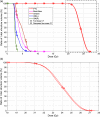Deep learning-based image quality improvement for low-dose computed tomography simulation in radiation therapy
- PMID: 31673567
- PMCID: PMC6811730
- DOI: 10.1117/1.JMI.6.4.043504
Deep learning-based image quality improvement for low-dose computed tomography simulation in radiation therapy
Abstract
Low-dose computed tomography (CT) is desirable for treatment planning and simulation in radiation therapy. Multiple rescanning and replanning during the treatment course with a smaller amount of dose than a single conventional full-dose CT simulation is a crucial step in adaptive radiation therapy. We developed a machine learning-based method to improve image quality of low-dose CT for radiation therapy treatment simulation. We used a residual block concept and a self-attention strategy with a cycle-consistent adversarial network framework. A fully convolution neural network with residual blocks and attention gates (AGs) was used in the generator to enable end-to-end transformation. We have collected CT images from 30 patients treated with frameless brain stereotactic radiosurgery (SRS) for this study. These full-dose images were used to generate projection data, which were then added with noise to simulate the low-mAs scanning scenario. Low-dose CT images were reconstructed from this noise-contaminated projection data and were fed into our network along with the original full-dose CT images for training. The performance of our network was evaluated by quantitatively comparing the high-quality CT images generated by our method with the original full-dose images. When mAs is reduced to 0.5% of the original CT scan, the mean square error of the CT images obtained by our method is , with respect to the original full-dose images. The proposed method successfully improved the noise, contract-to-noise ratio, and nonuniformity level to be close to those of full-dose CT images and outperforms a state-of-the-art iterative reconstruction method. Dosimetric studies show that the average differences of dose-volume histogram metrics are ( ). These quantitative results strongly indicate that the denoised low-dose CT images using our method maintains image accuracy and quality and are accurate enough for dose calculation in current CT simulation of brain SRS treatment. We also demonstrate the great potential for low-dose CT in the process of simulation and treatment planning.
Keywords: computed tomography; low dose; machine learning; radiation therapy.
© 2019 Society of Photo-Optical Instrumentation Engineers (SPIE).
Figures





Similar articles
-
MRI-based treatment planning for brain stereotactic radiosurgery: Dosimetric validation of a learning-based pseudo-CT generation method.Med Dosim. 2019 Autumn;44(3):199-204. doi: 10.1016/j.meddos.2018.06.008. Epub 2018 Aug 14. Med Dosim. 2019. PMID: 30115539 Free PMC article.
-
Paired cycle-GAN-based image correction for quantitative cone-beam computed tomography.Med Phys. 2019 Sep;46(9):3998-4009. doi: 10.1002/mp.13656. Epub 2019 Jul 17. Med Phys. 2019. PMID: 31206709 Free PMC article.
-
Dosimetric assessment of patient dose calculation on a deep learning-based synthesized computed tomography image for adaptive radiotherapy.J Appl Clin Med Phys. 2022 Jul;23(7):e13595. doi: 10.1002/acm2.13595. Epub 2022 Mar 25. J Appl Clin Med Phys. 2022. PMID: 35332646 Free PMC article.
-
Learning-based synthetic dual energy CT imaging from single energy CT for stopping power ratio calculation in proton radiation therapy.Br J Radiol. 2022 Jan 1;95(1129):20210644. doi: 10.1259/bjr.20210644. Epub 2021 Oct 28. Br J Radiol. 2022. PMID: 34709948 Free PMC article.
-
Noise spatial nonuniformity and the impact of statistical image reconstruction in CT myocardial perfusion imaging.Med Phys. 2012 Jul;39(7):4079-92. doi: 10.1118/1.4722983. Med Phys. 2012. PMID: 22830741 Free PMC article.
Cited by
-
A review of deep learning based methods for medical image multi-organ segmentation.Phys Med. 2021 May;85:107-122. doi: 10.1016/j.ejmp.2021.05.003. Epub 2021 May 13. Phys Med. 2021. PMID: 33992856 Free PMC article. Review.
-
Machine learning in quantitative PET: A review of attenuation correction and low-count image reconstruction methods.Phys Med. 2020 Aug;76:294-306. doi: 10.1016/j.ejmp.2020.07.028. Epub 2020 Jul 29. Phys Med. 2020. PMID: 32738777 Free PMC article. Review.
-
Real-time liver tumor localization via a single x-ray projection using deep graph neural network-assisted biomechanical modeling.Phys Med Biol. 2022 May 24;67(11):10.1088/1361-6560/ac6b7b. doi: 10.1088/1361-6560/ac6b7b. Phys Med Biol. 2022. PMID: 35483350 Free PMC article.
-
Standardization of scan protocols for RT CT simulator from different vendors using quantitative image quality technique.J Appl Clin Med Phys. 2024 Oct;25(10):e14484. doi: 10.1002/acm2.14484. Epub 2024 Aug 13. J Appl Clin Med Phys. 2024. PMID: 39137027 Free PMC article.
-
Deep learning in medical image registration: a review.Phys Med Biol. 2020 Oct 22;65(20):20TR01. doi: 10.1088/1361-6560/ab843e. Phys Med Biol. 2020. PMID: 32217829 Free PMC article. Review.

